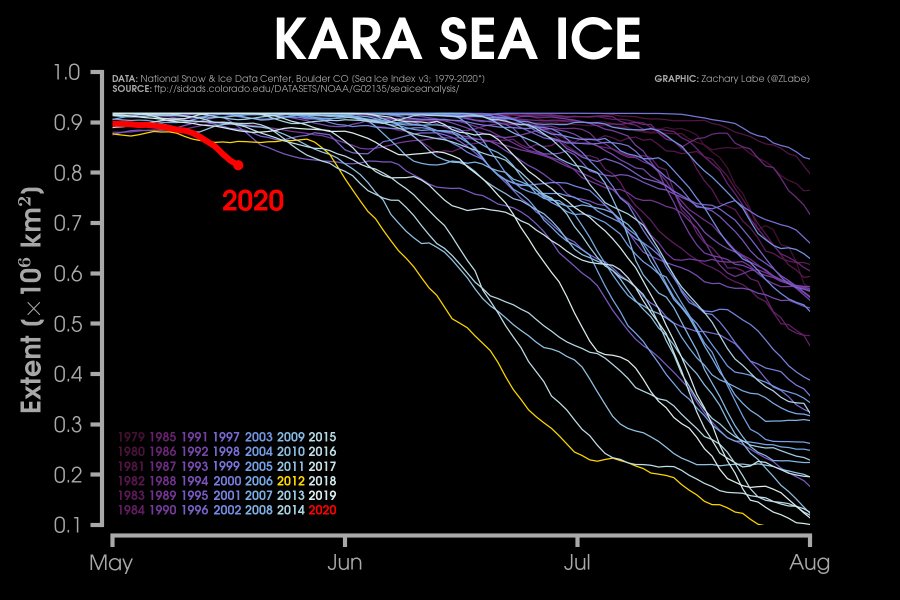WKN Weer, Klimaat en Natuurrampen
Lees alles over het onstuimige weer op onze planeet, volg orkanen en tornado's, zie hoe vulkanen uitbarsten en hoe Moeder Aarde beeft bij een aardbeving. Alles over de verwoestende kracht van onze planeet en tal van andere natuurverschijnselen.



quote:Largest glacier in Greenland is growing for third year in a row, thickening
Jakobshavn Glacier in western Greenland, best known for being world's fastest-moving glacier, is growing for the third year in a row. By the third year, thickening is occurring across an increasingly wide area.
The glacier has spent decades in retreat until scientists observed an unexpected advance between 2016 and 2017. In addition to growing toward the ocean, the glacier was found to be slowing and thickening.
Data collected in March 2019 confirm that the glacier has grown for the third year in a row, and scientists attribute the change to cool ocean waters, Kathryn Hansen of NASA's Earth Observatory reports.
"The third straight year of thickening of Greenland’s biggest glacier supports our conclusion that the ocean is the culprit," said Josh Willis, an ocean scientist at NASA’s Jet Propulsion Laboratory and principal investigator of the Oceans Melting Greenland (OMG) mission.
The maps below show how the glacier’s height changed between March 2016 and 2017 (top); March 2017 and 2018 (middle); and March 2018 and 2019 (bottom). The elevation data come from a radar altimeter that has been flown on research airplanes each spring as part of OMG. Blue areas represent where the glacier’s height has increased, in some areas by as much as 30 m (98 feet) per year.
The change is particularly striking at the glacier’s front (solid blue area on the left) between 2016 and 2017. That’s when the glacier advanced the most, replacing open water and sea ice with towering glacial ice. The glacier has not advanced as much since then, but it continues to slow and thicken.
Willis and colleagues think the glacier is reacting to a shift in a climate pattern called the North Atlantic Oscillation, which has brought cold water northward along Greenland’s west coast. Measurements of the temperatures collected by the OMG team show that the cold water has persisted.
The team will go back to Greenland in August.


quote:Large calving event imminent on Brunt Ice Shelf
Two large cracks, Chasm 1 and the ‘Halloween Crack’, are growing on the Brunt Ice Shelf in Antarctica and when they meet, a large iceberg around 3 times the size of Leeds (1,594 km2) will break off.
We use satellite images to measure the growth of both cracks on the Brunt Ice Shelf, along with tracking visible features on the ice shelf surface to measure the ice speed.
Chasm1, located on the West side of the Brunt Ice Shelf, lay dormant for 35 years, but in 2012 it showed signs of movement before starting to propagate across the ice shelf. In 2014 the crack began to grow even more rapidly, and is now over 55 km long! There is now only a 5 km bridge of ice between the tip of Chasm 1 and the McDonald Ice Rumples. When it breaks through, a new iceberg will calve.
A second fracture on the Eastern side of the Brunt Ice Shelf, named the ‘Halloween Crack’ because of its discovery on the 31st October 2016, is growing inland away from the McDonald Ice Rumples. Although the Halloween Crack is more recent, it is now also over 60 km long. Watch the drone footage below to fly along the length of the crack!


twitter:UniversityLeeds twitterde op dinsdag 25-06-2019 om 11:30:00 An iceberg larger than Greater London is about to break off from the Brunt Ice Shelf, Antarctica. Our @CPOM_news scientists are keeping a close eye on the cracks with colleagues from @ESA_EO and @BAS_News.See the latest data as it happens: https://t.co/C09R2YE8ua https://t.co/flllM7Ptsr reageer retweet
twitter:UniversityLeeds twitterde op dinsdag 25-06-2019 om 11:55:01 We could be just weeks or days away from the biggest iceberg calving event ever observed on the Brunt Ice Shelf. Dr Anna Hogg from @CPOM_news has a "live page" where you can see the latest @CopernicusEU satellite data as it comes in: https://t.co/C09R2YE8ua https://t.co/AsoB52SC0O reageer retweet


https://www.scientias.nl/(...)chrikbarend-snel-af/
Ook in Antarctica begint het afsmelten te versnellen.
Ook in Antarctica begint het afsmelten te versnellen.


Deze site al genoemd?
https://nsidc.org/arctics(...)ctive-sea-ice-graph/
Op het moment loopt het dit jaar gelijk met dezelfde periode in 2012.
https://nsidc.org/arctics(...)ctive-sea-ice-graph/
Op het moment loopt het dit jaar gelijk met dezelfde periode in 2012.


Het smelten gaat behoorlijk hard. Het lijkt erop dat 2019 zich gaat nestelen in de top 3 jaren met het laagste minimum. Tenzij we nu een koude periode krijgen voor de rest van juli en augustus, zoals het dat de laatste 2 jaar ook deed. Maar het lijkt er op dat de extreme hitte van de laatste weken nog even doorzet.
Цой жив


quote:This week, 40 billion tons of ice will melt in Greenland as the European heat wave moves north -- enough to measurably raise global sea levels.
This single heat wave will create a permanent change in our oceans that will linger for millennia.
We are in a climate emergency.
quote:A heat wave is starting tomorrow over Greenland with Tmax reaching 25°C in tundra. The integrated anomaly of melt over the next 5 days (resp. over Summer 2019) will be 40Gt ~0.11mm (resp. ~0.65mm) sea level equivalent. Summer 2019 = what the models project for 2050 using RCP85.


Maar geen probleem, want het is een lokaal fenomeen, dus wij kunnen gewoon doorstokenquote:'Ecological grief': Greenland residents traumatised by climate emergency
Islanders are struggling to reconcile impact of global heating with traditional way of life, survey finds
Life on thin ice: mental health at the heart of the climate crisis
The climate crisis is causing unprecedented levels of stress and anxiety to people in Greenland who are struggling to reconcile the traumatic impact of global heating with their traditional way of life.
The first ever national survey examining the human impact of the climate emergency, revealed in the Guardian on Monday, shows that more than 90% of islanders interviewed fully accept that the climate crisis is happening, with a further 76% claiming to have personally experienced global heating in their daily lives, from coping with dangerous sea ice journeys to having sled dogs euthanised for economic reasons tied to shorter winters.
The Greenlandic Perspectives Survey was carried out by the University of Copenhagen’s Center for Social Data Science, the Kraks Fond Institute for Urban Economic Research and the University of Greenland. The study samples almost 2% of the population, spanning an area almost three times the size of France. An equivalent study in the UK would involve a sample of almost 1 million citizens.
https://www.theguardian.c(...)by-climate-emergencyquote:He said: “The Arctic is a bellwether for the unequal impact of global warming on social and economic systems. As countries struggle to limit future risks and overall warming to 1.5C [an increase of 2.7F], many Arctic and Greenlandic residents are already living in regional climates that have changed by more than this, in less than a lifetime.


2019 volgt de dalende lijn van 2012 niet meer. Nog een week of drie en het ijs gaat weer aangroeien.


Het lijkt alsof het grote smelten aan een eind is gekomen. Geen nieuw dieptepunt dit jaar.
[ Bericht 1% gewijzigd door #ANONIEM op 28-08-2019 17:45:41 ]
[ Bericht 1% gewijzigd door #ANONIEM op 28-08-2019 17:45:41 ]


For 8.27, the NSIDC northern hemisphere sea ice extent value is 4.683 millions of square kilometers. This is an increase of 29,000 square kilometers.
NSIDC sea ice extent is now in third place for the date.
2019 now has 898,000 square kilometers more sea ice extent than 2012, 148,000 square kilometers more sea ice than 2016. 2019 now has 147,000 square kilometers less sea ice than 2007, 155,000 less sea ice than 2011 for the date.
We still have our first candidate for the 2019 northern hemisphere sea ice minimum (historically unprecedented and unlikely for minimum this early). We have seen sea ice extent gains in 4 of the last 5 days in the data set. We are now 55,000 squared kilometers above the August 22nd value.
2019 could fall to 5th place in the next 3 days, if the trend continues.
NSIDC sea ice extent is now in third place for the date.
2019 now has 898,000 square kilometers more sea ice extent than 2012, 148,000 square kilometers more sea ice than 2016. 2019 now has 147,000 square kilometers less sea ice than 2007, 155,000 less sea ice than 2011 for the date.
We still have our first candidate for the 2019 northern hemisphere sea ice minimum (historically unprecedented and unlikely for minimum this early). We have seen sea ice extent gains in 4 of the last 5 days in the data set. We are now 55,000 squared kilometers above the August 22nd value.
2019 could fall to 5th place in the next 3 days, if the trend continues.


Gelukkig dat de samenloop van weersomstandigheden dit jaar een nieuw record dieptepunt lijken te verhinderen.


Weinig zware stormen bedoel je?quote:Op dinsdag 3 september 2019 11:01 schreef cynicus het volgende:
Gelukkig dat de samenloop van weersomstandigheden dit jaar een nieuw record dieptepunt lijken te verhinderen.


Ja. Als er nu in plaats van kalm weer een grote cycloon op een 'gunstige' positie* zou zitten dan had dit jaar een nieuw diepte record kunnen worden.
* Referentie naar bijv. GAC2012
* Referentie naar bijv. GAC2012


quote:Op dinsdag 3 september 2019 12:15 schreef cynicus het volgende:
Ja. Als er nu in plaats van kalm weer een grote cycloon op een 'gunstige' positie* zou zitten dan had dit jaar een nieuw diepte record kunnen worden.
* Referentie naar bijv. GAC2012
Interessant om te lezen.


quote:SSW event above South Pole to go down as the strongest on record
Very rare Sudden Stratospheric Warming (SSW) event continues unfolding above the South Pole.
This SSW could go down in history as the strongest warming event on record, NIWA said, adding there is increased risk for southerlies in New Zealand into October.
SSW events are rare in the southern hemisphere, with only two in New Zealand in recorded times - one in September 2002 and the other in September 2010
The Australian Bureau of Meteorology is also predicting it as the strongest Antarctic warming on record, likely to exceed the previous record of September 2002 when New Zealand experienced its coldest October in 20 years.
Below-average temperatures covered much of the country in 2002, resulting in frequent ground frosts.
In 2010 SSW event – which is classed as a minor event – a number of rainfall records were broken with well below normal sunshine and very cold temperatures in parts of the South Island.
"Although we have seen plenty of weak or moderate variations in the polar vortex over the past 60 years, the only other true sudden stratospheric warming event in the Southern Hemisphere was in September 2002," BOM meteorologists said.
"Impacts from this stratospheric warming are likely to reach Earth’s surface in the next month and possibly extend through to January. Apart from warming the Antarctic region, the most notable effect will be a shift of the Southern Ocean westerly winds towards the Equator.
"For regions directly in the path of the strongest westerlies, which includes western Tasmania, New Zealand’s South Island, and Patagonia in South America, this generally results in more storminess and rainfall, and colder temperatures. But for subtropical Australia, which largely sits north of the main belt of westerlies, the shift results in reduced rainfall, clearer skies, and warmer temperatures.
"Past stratospheric warming events and associated wind changes have had their strongest effects in NSW and southern Queensland, where springtime temperatures increased, rainfall decreased and heatwaves and fire risk rose."
twitter:NiwaWeather twitterde op dinsdag 10-09-2019 om 02:57:51 Sudden Stratospheric Warming update?? It happened and continues to unfold.? It set high temperature records in the stratosphere.? It could go down as the strongest warming event on record.? Increased risk for southerlies in New Zealand into October ? https://t.co/mEZcRyV74u reageer retweet


twitter:weermanreinier twitterde op vrijdag 13-09-2019 om 17:50:16 Omdat mensen me vaak vragen hoe het met het Noordpool ijs ging voor 1979 (begin satellietwaarnemingen), hier de reconstructie vanaf 1850! Grafiek voor medio September. Nu (12/9) zitten we op 4,3 miljoen KM2 volgens data NSIDC. https://t.co/CXpicg3Nt0 reageer retweet


Een schip dat vast komt te zitten in het Arctisch zee-ijs: het is de nachtmerrie van elke kapitein. Behalve dan die van de ijsbreker Polarstern. Het onderzoeksschip vertrekt volgende maand naar de Noordpool met als doel: vastlopen in het Arctisch zee-ijs en zich weerloos mee laten voeren door de zeestromingen. Aan boord van de ijsbreker bevinden zich onderzoekers die vanaf dit drijvende laboratorium onder meer onderzoek doen naar klimaatverandering in het Noordpoolgebied, de gevolgen die het verdwijnen van het zee-ijs heeft, de atmosfeer en het lokale ecosysteem. Uiteindelijk moet de expeditie – die de naam Multidisciplinary drifting Observatory for the Study of Arctic Climate (MOSAIC) draagt, resulteren in betere klimaat- en weersvoorspellingen.
rest van verhaal
rest van verhaal


Mooi idd.quote:Op zaterdag 14 september 2019 09:55 schreef Basp1 het volgende:
Mooie animatie waarin duidelijk het verlies van meerjarig ijs te zien is over de afgelopen 25 jaar.
Blijft weinig van over.


Fridjof Nansen deed het al eerder in 1893quote:Op zaterdag 14 september 2019 09:43 schreef aloa het volgende:
Een schip dat vast komt te zitten in het Arctisch zee-ijs: het is de nachtmerrie van elke kapitein. Behalve dan die van de ijsbreker Polarstern. Het onderzoeksschip vertrekt volgende maand naar de Noordpool met als doel: vastlopen in het Arctisch zee-ijs en zich weerloos mee laten voeren door de zeestromingen. Aan boord van de ijsbreker bevinden zich onderzoekers die vanaf dit drijvende laboratorium onder meer onderzoek doen naar klimaatverandering in het Noordpoolgebied, de gevolgen die het verdwijnen van het zee-ijs heeft, de atmosfeer en het lokale ecosysteem. Uiteindelijk moet de expeditie – die de naam Multidisciplinary drifting Observatory for the Study of Arctic Climate (MOSAIC) draagt, resulteren in betere klimaat- en weersvoorspellingen.
rest van verhaal
En mocht je van spannende avontuurlijke boeken houden, dan is het boek dat hij over die expeditie geschreven heeft een dikke aanrader.
ph'nglui mglw'nafh Cthulhu R'lyeh wgah'nagl fhtagn


Small decreases in sea ice extent are still ongoing in the #Arctic. This year is falling very close to 2007 and 2016 in the JAXA data set. We have not reached the minimum yet.


Zal nog te maken hebben met de stormen die nu nog huishouden daar.quote:Op zaterdag 14 september 2019 17:41 schreef Adrie072 het volgende:
Small decreases in sea ice extent are still ongoing in the #Arctic. This year is falling very close to 2007 and 2016 in the JAXA data set. We have not reached the minimum yet.
[ afbeelding ]


De Russen hebben een lange traditie om in de winter onderzoeks stations op het Arctische zeeijs te bouwen, welke uiteraard ook met de stromingen mee zwerven. Vanaf 1950 is dit vrijwel elk jaar gedaan, behalve een periode na het ineenstorten van de Sovjet Unie.
https://en.wikipedia.org/wiki/Drifting_ice_station
https://en.wikipedia.org/wiki/Drifting_ice_station


Voor de 2de keer onder de 4 miljoen km2 sinds het begin van de metingen.quote:Op maandag 16 september 2019 19:15 schreef barthol het volgende:
https://ads.nipr.ac.jp/vishop/#/extent
De exent is nu lager dan 2016 en 2007. Tweede plaats na 2012
Цой жив


twitter:fmeeus1 twitterde op woensdag 25-12-2019 om 16:11:32 NASA bevestigt : grootste gletsjer in Groenland is sinds 2016 aan het groeien, al 3 jaar na mekaar. Nochtans CO2 is flink gestegen. Oorzaak toename ijsmassa waarschijnlijk door natuurlijke koud water oscillatie. https://t.co/OI7TIfA5Gp reageer retweet


Wat triest, die Twitterraar is weer zo'n typische twijfelzaaier met een lange lijst van standaard en tig maal ontkrachte meme's.quote:Op donderdag 26 december 2019 18:03 schreef InverHouse het volgende:
[ afbeelding ]twitter:fmeeus1 twitterde op woensdag 25-12-2019 om 16:11:32 NASA bevestigt : grootste gletsjer in Groenland is sinds 2016 aan het groeien, al 3 jaar na mekaar. Nochtans CO2 is flink gestegen. Oorzaak toename ijsmassa waarschijnlijk door natuurlijke koud water oscillatie. https://t.co/OI7TIfA5Gp reageer retweet


quote:IJsberg ter grootte van Malta losgebroken van Antarctica
Aan de westkant van Antarctica is eerder deze maand een enorme ijsberg losgebroken, zo blijkt uit satellietbeelden. De bevroren massa heeft een oppervlak van 300 vierkante kilometer en is daarmee ongeveer even groot als Malta.
Op satellietbeelden van het European Space Agency (ESA) was eerder deze maand te zien hoe een enorme scheur was ontstaan in de Pine Island-gletsjer. Een paar dagen later brak de ijsberg af, waarna het gevaarte in meerdere stukken brak.
'Prachtig en angstaanjagend'
"Waar we naar kijken is zowel prachtig als angstaanjagend", zegt Mark Drinkwater van het ESA tegen CNN. Volgens hem is het afbreken van het enorme stuk ijs een direct gevolg van klimaatverandering.
Het komt op Antarctica vaker voor dat ijsbergen losbreken, maar volgens Drinkwater gebeurt het tegenwoordig veel frequenter dan voorheen. Bovendien zou de gletsjer door de stijgende watertemperatuur en een gebrek aan sneeuw niet in staat zijn zichzelf te repareren. Recentelijk werd op Antarctica de hoogste temperatuur ooit gemeten: 18 graden Celsius.
De Pine Island-gletsjer is een van de grootste gletsjers op Antarctica. Samen met de Thwaites-gletsjer vormt die een ijsmassa die bij smelting voor een stijging van 1,2 meter van de zeespiegel zou zorgen. "Dat zou een enorme economische en maatschappelijke impact hebben."
De afgelopen jaren zijn van de Pine Island-gletsjer vaker grote ijsbergen losgebroken. In 2013 brak een stuk ijsmassa af met een oppervlak ter grootte van Singapore.


twitter:NWSHanford twitterde op zaterdag 11-04-2020 om 20:47:07 Here is a picture of snow rollers as seen yesterday (4/10/20) in the Southern Sierra Nevada at an elevation of 8,700 feet. Snow rollers are rare and usually only a few inches wide. These snow rollers were up to two feet in diameter. Picture submitted by Brice Jury. #CAwx https://t.co/FNsMHaNd2A reageer retweet


Apart verschijnsel.quote:Op zondag 12 april 2020 14:42 schreef Adrie072 het volgende:
[ afbeelding ]twitter:NWSHanford twitterde op zaterdag 11-04-2020 om 20:47:07 Here is a picture of snow rollers as seen yesterday (4/10/20) in the Southern Sierra Nevada at an elevation of 8,700 feet. Snow rollers are rare and usually only a few inches wide. These snow rollers were up to two feet in diameter. Picture submitted by Brice Jury. #CAwx https://t.co/FNsMHaNd2A reageer retweet


twitter:janvissersweer twitterde op woensdag 13-05-2020 om 17:58:59 Opsteker! Voor het eerst sinds 2004 is zee-ijs in de wateren bij Oost-Groenland er in geslaagd om het eiland Jan Mayen te bereiken. Foto van Maiken Vassel). https://t.co/9wzQoN1OBB https://t.co/aLEIgOrSAH reageer retweet


twitter:ZLabe twitterde op woensdag 20-05-2020 om 17:35:50 Striking to compare the timing differences in the start of the summer melt season in the Kara Sea - for instance, look at 2020 (red line) relative to the 1980s (purple lines) https://t.co/9XkWTLONZQ reageer retweet


Last Friday, Antarctica set its coldest EVER March temperature…
…somehow, in what we’re to believe is a linearly warming world on the brink of “overheating”, the world’s southernmost continent is currently the coldest its ever been for the time of year.
The Vostok Station clocked a bone-chilling -75.3C (-103.54F) on the morning of Friday, March 20, as spotted by @TempGlobal on Twitter:
https://electroverse.net/(...)t-march-temperature/
…somehow, in what we’re to believe is a linearly warming world on the brink of “overheating”, the world’s southernmost continent is currently the coldest its ever been for the time of year.
The Vostok Station clocked a bone-chilling -75.3C (-103.54F) on the morning of Friday, March 20, as spotted by @TempGlobal on Twitter:
https://electroverse.net/(...)t-march-temperature/


Wat een kak. Sensationeel, dat wel, maar nog steeds kak. Niemand* verwacht een lineair opwarmende wereld, of dat we op de vooravond van een overheating planeet staan (of wat dat ook maar mag betekenen).quote:…somehow, in what we’re to believe is a linearly warming world on the brink of “overheating”, the world’s southernmost continent is currently the coldest its ever been for the time of year.
In een opwarmende wereld verwachten we dat de verhouding warme/koude records in de richting van warm opschuift maar niemand* beweert dat een kouderecord niet meer kan voorkomen.
Gewoon kak van een kakwebsite. Zo.
* met enige kennis van zaken.


‘Thermische brandhaard’ Siberië: Verchojansk vestigt alltime hitterecord met 38,0º.
En weer is een deel van Siberië uitgegroeid tot een ‘thermische brandhaard’. Dit keer gaat het om het noordoostelijk deel van het immense gebied. Vrijdag werd in Chokurdakh, gelegen op de 71ste breedtegraad, met 31,4º een nieuw warmterecord voor juni gevestigd. Het vorige was 30,0º op 30 juni 1964. Nog warmer was het in de nederzetting Verchojansk. Daar zinderde het kwik naar 34,0º en dat betekende een evenaring van het junirecord uit 1990. Toen liep het kwik op de 16de eveneens op naar 34,0º. De extreme Siberische warmte is al lang geen incident meer. Vorig jaar werd het in juni in Verchojansk weliswaar op geen enkele dag tenminste 30º: wel werden er maar liefst 19 zomerse dagen geregistreerd en met gemiddeld 17,9 tegen normaal 13,2º was het de warmste zonnewendemaand in een reeks vanaf 1869. Het ‘voortschrijdend maandgemiddelde’ van juni 2020 is 16,2º
BREAKING WEATHER: In Verchojansk is het vandaag 38,0º geworden. Nimmer was het daar zo heet! Het alltime hitterecord was 37,3º op 25 juli 1988.
https://janvissersweer.nl/
En weer is een deel van Siberië uitgegroeid tot een ‘thermische brandhaard’. Dit keer gaat het om het noordoostelijk deel van het immense gebied. Vrijdag werd in Chokurdakh, gelegen op de 71ste breedtegraad, met 31,4º een nieuw warmterecord voor juni gevestigd. Het vorige was 30,0º op 30 juni 1964. Nog warmer was het in de nederzetting Verchojansk. Daar zinderde het kwik naar 34,0º en dat betekende een evenaring van het junirecord uit 1990. Toen liep het kwik op de 16de eveneens op naar 34,0º. De extreme Siberische warmte is al lang geen incident meer. Vorig jaar werd het in juni in Verchojansk weliswaar op geen enkele dag tenminste 30º: wel werden er maar liefst 19 zomerse dagen geregistreerd en met gemiddeld 17,9 tegen normaal 13,2º was het de warmste zonnewendemaand in een reeks vanaf 1869. Het ‘voortschrijdend maandgemiddelde’ van juni 2020 is 16,2º
BREAKING WEATHER: In Verchojansk is het vandaag 38,0º geworden. Nimmer was het daar zo heet! Het alltime hitterecord was 37,3º op 25 juli 1988.
https://janvissersweer.nl/


Roze sneeuw in Italiaanse Alpen (en dat is slecht nieuws)
Het is een opmerkelijk gezicht in de Italiaanse Alpen. In de noordelijke regio Trentino-Zuid-Tirol kleurt de sneeuw op enkele bergtoppen niet wit, maar lichtroze. Vermoedelijk komt de verkleuring door algen en zorgen die ervoor dat de sneeuw sneller smelt.
Dat sneeuw roze kleurt is ongebruikelijk, maar het komt vaker voor. Een Italiaanse wetenschapper die onderzoek deed naar de verkleuring denkt dat die veroorzaakt wordt door de algensoort Ancylonema nordenskioeldii. Die alg wordt tijdens de lente en zomer ook weleens waargenomen op Groenland en bij de Noord- en Zuidpool
De soort is niet gevaarlijk voor de natuur, maar zorgt er wel voor dat sneeuw sneller smelt. Normaal gesproken weerkaatst het witte sneeuw de meeste zonlicht, maar door de roze gloed absorbeert de warmte en ontdooit de sneeuw. Daardoor krijgen de algen meer water en lucht en komen er meer algen bij. De effecten van klimaatverandering worden zo nog sneller zichtbaar, waarschuwen onderzoekers.
Toerisme
Wat het probleem heeft veroorzaakt is niet met zekerheid te zeggen. Mogelijk hebben bergbeklimmers- en wintersporttoerisme in het gebied daaraan bijgedragen.
https://www.rtlnieuws.nl/(...)euw-italiaanse-alpen


Het is bijna geen nieuws meer maar ook dit jaar hoort tot dusver in de top van minste Arctisch zeeijs. Zowel extent als area zijn weer record-laag op dit moment. Voor uitspraken over wel/geen nieuw record minimum is het nog te vroeg aangezien dit erg weersafhankelijk is maar het ijs is er ook dit jaar weer slecht aan toe.
Area:
Extent:
Area:
Extent:


Het momentum blijft aanhouden. Ik denk dat 2020 waarschijnlijk wel een 2de plaats gaat halen. 2012 blijft moeilijk om voor te blijven.
De hoeveelheid ijs is nu al ruim onder het gemiddelde september minimum in de jaren 90.
De hoeveelheid ijs is nu al ruim onder het gemiddelde september minimum in de jaren 90.
Цой жив



 An iceberg larger than Greater London is about to break off from the Brunt Ice Shelf, Antarctica. Our @
An iceberg larger than Greater London is about to break off from the Brunt Ice Shelf, Antarctica. Our @
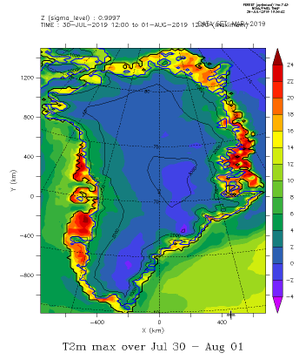






 Sudden Stratospheric Warming update?? It happened and continues to unfold.? It set high temperature records in the stratosphere.? It could go down as the strongest warming event on record.? Increased risk for southerlies in New Zealand into October ?
Sudden Stratospheric Warming update?? It happened and continues to unfold.? It set high temperature records in the stratosphere.? It could go down as the strongest warming event on record.? Increased risk for southerlies in New Zealand into October ? 

 Omdat mensen me vaak vragen hoe het met het Noordpool ijs ging voor 1979 (begin satellietwaarnemingen), hier de reconstructie vanaf 1850! Grafiek voor medio September. Nu (12/9) zitten we op 4,3 miljoen KM2 volgens data NSIDC.
Omdat mensen me vaak vragen hoe het met het Noordpool ijs ging voor 1979 (begin satellietwaarnemingen), hier de reconstructie vanaf 1850! Grafiek voor medio September. Nu (12/9) zitten we op 4,3 miljoen KM2 volgens data NSIDC. 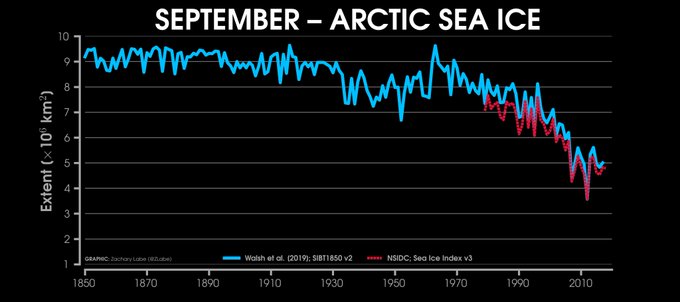

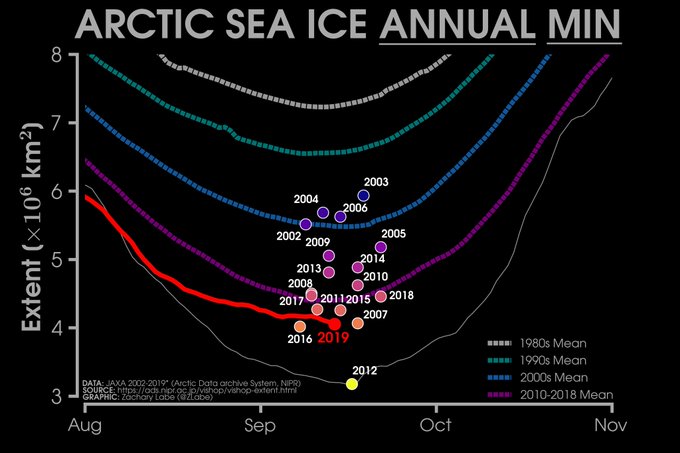
 NASA bevestigt : grootste gletsjer in Groenland is sinds 2016 aan het groeien, al 3 jaar na mekaar. Nochtans CO2 is flink gestegen. Oorzaak toename ijsmassa waarschijnlijk door natuurlijke koud water oscillatie.
NASA bevestigt : grootste gletsjer in Groenland is sinds 2016 aan het groeien, al 3 jaar na mekaar. Nochtans CO2 is flink gestegen. Oorzaak toename ijsmassa waarschijnlijk door natuurlijke koud water oscillatie. 
 Here is a picture of snow rollers as seen yesterday (4/10/20) in the Southern Sierra Nevada at an elevation of 8,700 feet. Snow rollers are rare and usually only a few inches wide. These snow rollers were up to two feet in diameter. Picture submitted by Brice Jury.
Here is a picture of snow rollers as seen yesterday (4/10/20) in the Southern Sierra Nevada at an elevation of 8,700 feet. Snow rollers are rare and usually only a few inches wide. These snow rollers were up to two feet in diameter. Picture submitted by Brice Jury. 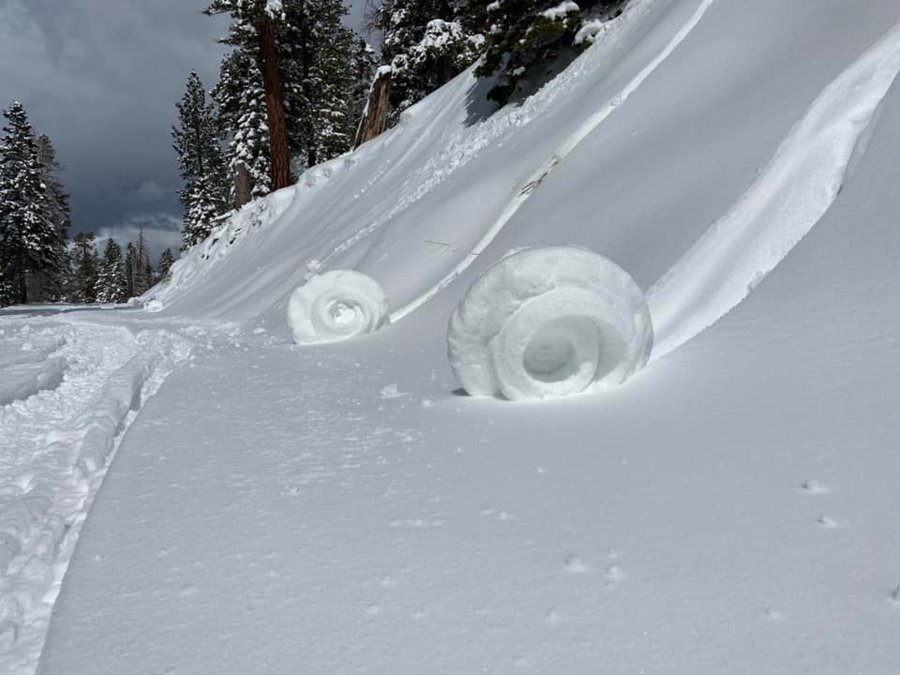
 Opsteker! Voor het eerst sinds 2004 is zee-ijs in de wateren bij Oost-Groenland er in geslaagd om het eiland Jan Mayen te bereiken. Foto van Maiken Vassel).
Opsteker! Voor het eerst sinds 2004 is zee-ijs in de wateren bij Oost-Groenland er in geslaagd om het eiland Jan Mayen te bereiken. Foto van Maiken Vassel).  Striking to compare the timing differences in the start of the summer melt season in the Kara Sea - for instance, look at 2020 (red line) relative to the 1980s (purple lines)
Striking to compare the timing differences in the start of the summer melt season in the Kara Sea - for instance, look at 2020 (red line) relative to the 1980s (purple lines) 